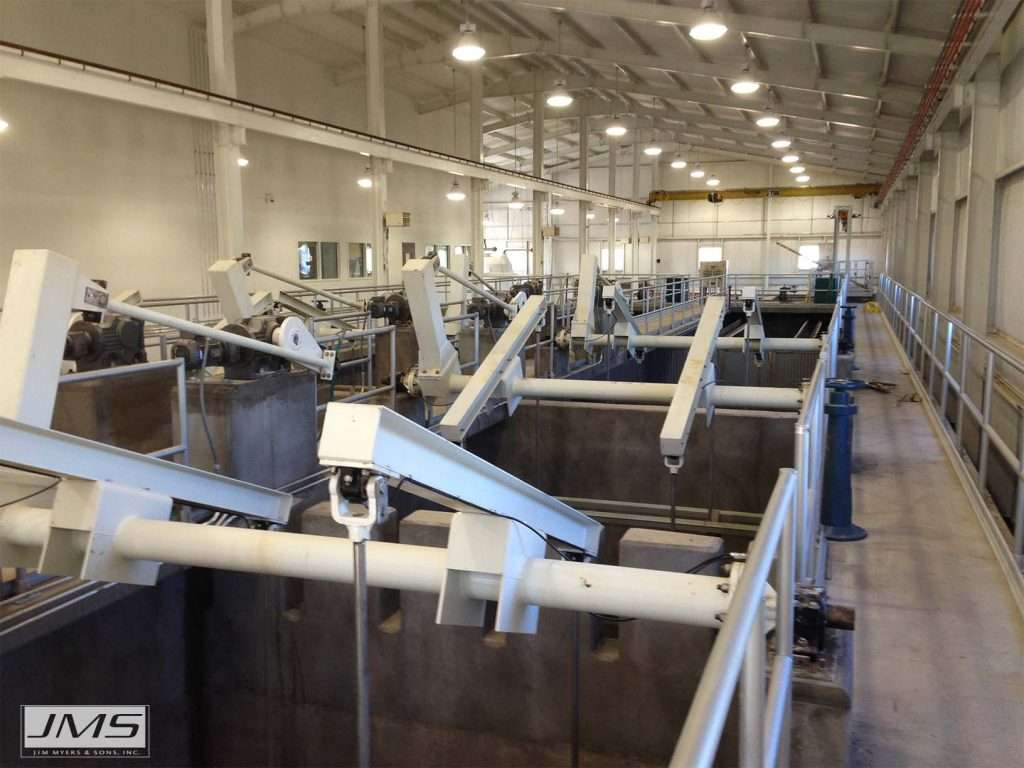
The Mega-FLOC (Walking Beam Flocculator) is often used in deep basins and where the highest quality floc particle is desired. This system is overwhelmingly selected for its proven flocculation process performance, quality, safety, ease of maintenance, low lifetime cost of ownership and longevity.
One of the most effective and reliable systems available today, the Mega-FLOC (Walking Beam Paddle Wheel Flocculator) uses reciprocating vertical paddle motion to achieve the wide range of velocities needed to optimize flocculation performance. Linear paddle velocities vary cyclically from zero feet per second to an adjustable maximum rate deemed ideal for effective solids flocculation without risk of floc shear. An upstroke suction lift on the bottom of the basin prevents floc fallout and aids in seeding the newly forming floc, while a downstroke generates turbulence to aid the production of robust floc particles. As motion is continuously transmitted to all areas of the basin, dead spots are eliminated, as is the risk of mass rotation, laminar flow and short-circuiting.
To achieve the unique oscillating stroke, all motion is transferred through heavy duty roller bearings located above the water level. Drop arms are connected to both ends of a series of walking beams by clevis and pin connected to a pillow block roller bearing. The walking beams, spaced laterally on horizontal drive shafts, are mounted on piers by self-aligning bearing assemblies. Pillow block roller bearings (used on both walking beams and connecting rods) are anchored using stainless steel baseplate assemblies.

Key features
- Linear up-down motion maximizes Brownian motion
- Unique non-rotational mixing creates the best, highest quality floc particle
- Moving parts are above water for ease of maintenance
- Durability promotes low life cycle costs
- Certified to ANSI/NSF-61 standards
Success Story

The town of Quitman, AR is located in the picturesque Ozark Mounains. Known for great fishing lakes and streams, the area’s abundant surface water provides adequate intake capacity for the Lonoke White Water Treatment Plant. With the need to service 80,000 residents and a vision for growth, groundbreaking for this new 10 MGD water plant took place in 2010.
Under the professional guidance of Crist Engineers, equipment selection was made based on supplier qualifications and experience. JMS, with plenty of both, also had the advantage of working with the engineering firm on another successful Arkansas project. When all the bids were in, JMS was asked to supply their Mega-FLOC (Walking Beam Flocculator) and Mega-SETTLER Plate Settler System.
Now in full-time operation, Lonoke White Water Project is considered a great success. Plant manager David Liles, brought in to run the operation, expresses his pleasure with the low maintenance nature of the JMS equipment. He has found he prefers the low shear mixing action of the Mega-FLOC (Walking Beam Flocculator) over the rapid mix units he had worked with at another plant. With the durability of JMS equipment, this plant looks forward to years of trouble-free performance.
The JMS Way
#18
Practice productive problem solving.
Just fix it. Apply your creativity and enthusiasm to developing solutions, rather than pointing fingers or dwelling on problems. Identify lessons learned and use those lessons to improve ourselves and our processes so we don’t make the same mistake twice.
